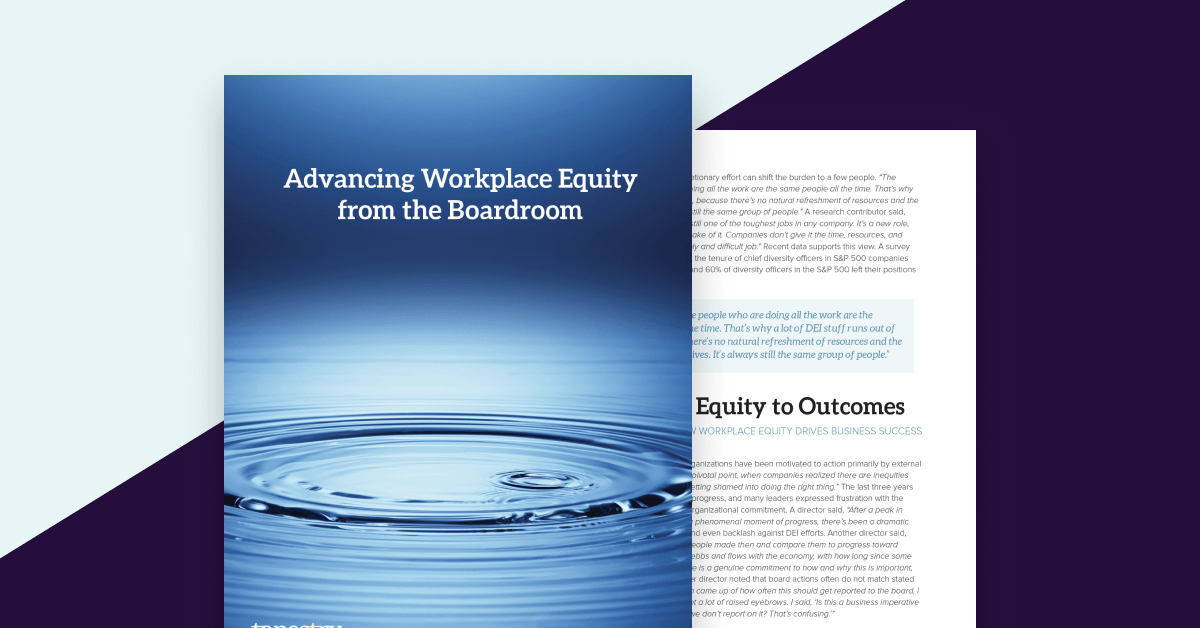At its core, workplace equity is about trust between employers and employees. Do employees trust that leaders truly value them for what they contribute to the success of the company?
That’s why I closed my keynote speech at the recent WorldatWork Workplace Equity Forum ‘22 by challenging corporate leaders in HR, the champions of workplace equity, to use this moment to “fundamentally change the relationship between leadership and employees by implementing processes and strategies that lead to a more equitable workplace.”
It’s easy to get all hyped up at an event like the Workplace Equity Forum — only to return to your workplace and wonder, “How do I actually get my company to make these kinds of changes?”
Seizing the moment to pursue progress in workplace equity requires careful change management. Change of any kind can be uncomfortable and has the potential to trigger backlash. Sometimes change is uncomfortable, but necessary to evolve. Successfully pushing for workplace equity investment and efforts at your organization will require you to gain commitments from the very top — and achieving that level of buy-in will require you to build a compelling narrative founded on proof.
To help you prepare to present your business case for workplace equity to executive leadership, I partnered with Scott Cawood, CEO of WorldatWork. Scott leads WorldatWork’s mission to serve, educate, and inspire professionals dedicated to building more effective, rewarding, and equitable workplaces. Below we offer tips for structuring a compelling conversation around workplace equity with your C-suite and other leadership.
7 tips for structuring compelling workplace equity conversations with leadership
1. Clarify the benefits and the ask.
We heard from many HR leaders at WorldatWork that their leadership was “unimpressed” or “uninterested” by claims of progress against workplace equity goals. If this resonates, you may need to hone and refine the story you are telling. Make sure to illustrate that workplace equity is not just busy work or “do goodery”. This work reduces the risk of costly litigation, brand catastrophe and turnover. In fact, in a 2022 Gartner report research showed that by 2025, organizations that remediate gender pay gaps will decrease women’s attrition by 30%, reducing pressure on talent shortages.
Once you clarify the benefits, you can get very clear with leadership about what you want. What’s the ask? Do you want more transparency around pay? A statement on ESG? A public-facing commitment to ongoing pay equity analyses or median pay gap? All of these are worthy aspirations and can be achieved by linking to the positive business outcomes that will come as a result.
Workplace equity isn’t going to be solved in a single swoop, so take the time upfront to figure out where to prioritize your efforts. Consider leveraging workplace equity analytics software to help you use data to pinpoint where your time and resources can have the greatest impact on progress.
2. Know your audience.
If you’re a Total Rewards/Compensation, HR, or DE&I professional, you’ve likely got your own passions and priorities when it comes to workplace equity. But to successfully get buy-in from leadership, you’ve got to put yourself in their shoes — what keeps them up at night in regards to the business? Your message must link back to what is most important to them.
C-suite leaders are stewards of your company’s long-term goals and growth. Some may view every proposal through the lens of risk mitigation, especially in today’s volatile economy. Some are motivated by being on the leading edge of their industry and the “fear of missing out.” Some are squarely focused on the impact to the bottom line. Center your workplace equity proposal around these concerns.
For the risk-oriented executives, clearly lay out the throughline from workplace equity to the employee experience, talent retention, and cost control (e.g., it costs a heck of a lot more to recruit and hire new talent than to keep existing workers employed). For executives who want to stay ahead of their peers, show data around what other leading companies are doing around workplace equity.
3. Make allies with leadership “influencers.”
Who are the people that your executive team is influenced by? Talk to those people to learn the right levers to push to appeal to specific leaders and partner with these influencers to help shore up your case. Ask them “This is what I want to talk to leadership about — what do you think?” Find out what certain leaders may focus on and what might be “pump the brakes” wording that could stop the conversation in its tracks.
One tactical suggestion is to hold a strategy session with several influencers to analyze your stakeholders ahead of time to develop your key messaging. Iron out what you want leadership to do, think, and say, and then build your case around that. Need some help? Syndio’s team of expert advisors can support a strategy session for workplace equity.
4. Keep your story “high and tight.”
Executives are busy and often want to drive to the heart of a business matter as directly as possible. The term “executive summary” exists for a reason! Be extremely selective around your key points and keep your proposal high-level. Start with the ending first — the one thing you want them to take away from the conversation — and then succinctly walk them through supportive messaging. Be sparing with data and only choose the most high impact data points that support the key beats of your story.
As mentioned in #1 above, be clear on your ask of leadership — and clearly connect the dots to why the company will be at a competitive disadvantage if they don’t take action.
5. Use data to your advantage.
Be very crisp in preparing internal numbers around what percentage of the organization will be impacted by the changes you recommend, what costs are associated with these changes, and what the timelines and steps are.
Data should be used to score strategic bullseyes, rather than as scattershot. As discussed above, be highly selective and only use the most high impact data points.
Also be sure to research what your competitors are doing. In the context of workplace equity, your competitors are the companies that you compete with for talent. Outline how making your recommended changes will help differentiate your organization and provide a competitive advantage in the labor market.
One tactic we recommend is to utilize employee listening so that you can bring the employee voice into the conversation. It can be very powerful to share what employees are saying and tie that back to employee experience and retention — and how that connects to the bottom line.
6. Create a feedback loop.
Achieving progress around workplace equity will take more than a “one and done” conversation. You’re going to have to share your message a few times to several (or many) different people. A major component of persuasion is listening. Don’t just talk at leadership, but listen to what they’re saying and build a feedback loop that applies their responses to strengthen your case going forward. If someone says “I don’t want to do that,” dig into the “why” behind their response. Then collaborate with them to come up with solutions that will help them become comfortable with the proposed change.
In a webinar with Syndio, Adam Swanlund, Compensation Manager for Elevance Health (formerly Anthem), shared how he got leadership buy-in to “do something different” around workplace equity at his company. Adam said, “It’s the willingness to listen, change, and shape the way that you work through things, as well as understanding that you need to be able to justify why you’re making specific pay decisions. It’s about having a meaningful conversation and listening to the concerns and the limitations of the business.”
7. Plan for a “no” and leverage your network internally to ‘manage up.’
No matter how well prepared your business case may be, it just might not be the right timing. If you hear a “no” to a request for resources or for greater transparency, don’t take that as a “no forever,” but instead view it as a “no for now.”
In the meantime, think about what changes you can make within your realm of influence. What do you have control over? It may be more than you realize, so lean into your power! Workplace equity can sometimes take a while to “seed” within an organization, so continue beating the drum and rope in allies along the way. If the C-suite isn’t bought in, but managers seem to be, build out this network of influencers and keep sharing your message around where workplace equity is heading.
The trend towards workplace equity as a business imperative will eventually reinforce your message. In the U.S., 1 in 3 workers are subject to laws requiring some form of pay transparency now or in the near future, and California just became the first state in the country to require mean and median pay gap reporting. In addition to expanding legislation, leading companies are future-proofing by adopting a nationwide approach to salary range transparency — for example, Microsoft has announced that, starting no later than January 2023, they will post salary ranges for all job openings. Whether your leaders are on board or not, it’s clear that companies are heading in the direction of greater pay transparency and investing in both pay and opportunity equity.
Want to ‘re-recruit’ employees? Workplace equity buy-in matters
Research from global HR analyst Josh Bersin shows that workplace equity is a critical component of a positive employee experience. Re-engaging employees by building a culture of trust requires a top-down commitment. That’s why C-suite leaders who want to future-proof their brands’ reputation and ability to generate value for stakeholders are embracing workplace equity initiatives and applying their authority to these efforts. In fact, 57% of respondents in the 2023 Workplace Equity Trends Report felt that their leadership is truly bought-in to their workplace equity program. But it’s not always an easy road to convince executives that it should be a business priority.
The HR, Total Rewards/Compensation, and DE&I professionals who decide to champion workplace equity will be the champions of the entire workplace. Getting buy-in around workplace equity from your executive team is a worthwhile effort, because it will lay the foundation for building trust between leadership and employees. And that is something worth fighting for.
Want more supporting data points around the ROI of workplace equity? Check out our Business Case for Workplace Equity infographic linked below.
The information provided herein does not, and is not intended to, constitute legal advice. All information, content, and materials are provided for general informational purposes only. The links to third-party or government websites are offered for the convenience of the reader; Syndio is not responsible for the contents on linked pages.


